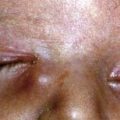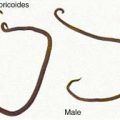Chapter 216 Genital Mycoplasmas (Mycoplasma hominis, Mycoplasma genitalium, and Ureaplasma urealyticum)
Clinical Manifestations
U. urealyticum and M. genitalium are recognized pathogens of NGU. Approximately 30% of NGU in male patients may be caused by these organisms either alone or with Chlamydia trachomatis (Chapter 516.1). Disease is most common in young adults but is also prevalent in sexually active adolescents. The average incubation period is 2-3 wk, with symptoms typically consisting of scant mucoid-white urethral discharge, dysuria, and penile discomfort. The discharge is often evident only in the morning or after the urethra is stripped. Rare complications of NGU are epididymitis and proctitis. Approximately 20-60% of patients with M. genitalium NGU develop recurrent or chronic urethritis despite 1-2 wk of treatment with doxycycline alone.
Anagius C, Lore B, Jensen JS. Mycoplasma genitalium: prevalence, clinical significance, and transmission. Sex Transm Infect. 2005;81:458-462.
Goldenberg RL, Andrews WW, Goepfert AR, et al. The Alabama preterm birth study: umbilical cord blood Ureaplasma urealyticum and Mycoplasma hominis cultures in very preterm newborns. Am J Obstet Gynecol. 2008;198:43.e1-43.e5.
Hata A, Honda Y, Asada K, et al. Mycoplasma hominis meningitis in a neonate: case report and review. J Infect. 2008;57:338-343.
Jensen JS. Single-dose azithromycin treatment for Mycoplasma genitalium–positive urethritis: best but not good enough. Clin Infect Dis. 2009;48:1655-1656.
Maxwell NG, Nuttall D, Kotecha S. Does Ureaplasma spp. cause chronic lung disease of prematurity: ask the audience? Early Hum Dev. 2009;85:291-296.
Mena LA, Mroczkowski TF, Nsuami M, et al. A randomized comparison of azithromycin and doxycycline for the treatment of Mycoplasma genitalium–positive urethritis in men. Clin Infect Dis. 2009;48:1649-1654.
Olomu IN, Hecht JL, Onderdonk AG, et al. Perinatal correlates of Ureaplasma urealyticum in placenta parenchyma of singleton pregnancies that end before 28 weeks of gestation. Pediatrics. 2009;123:1329-1336.
Schelonka RL, Waites KB. Ureaplasma infection and neonatal lung disease. Semin Perinatol. 2007;31:2-9.
She RC, Simmon KE, Bender JM. Mollicute infections in neonates. Pediatr Infect Dis J. 2009;28:248-250.
Yokoi S, Maeda S, Kubota Y, et al. The role of Mycoplasma genitalium and Ureaplasma urealyticum biovar 2 in postgonococcal urethritis. Clin Infect Dis. 2007;45:866-871.
Waites KB, Katz B, Schelonka RL. Mycoplasmas and ureaplasmas as neonatal pathogens. Clin Microbiol Rev. 2005;18:757-789.






